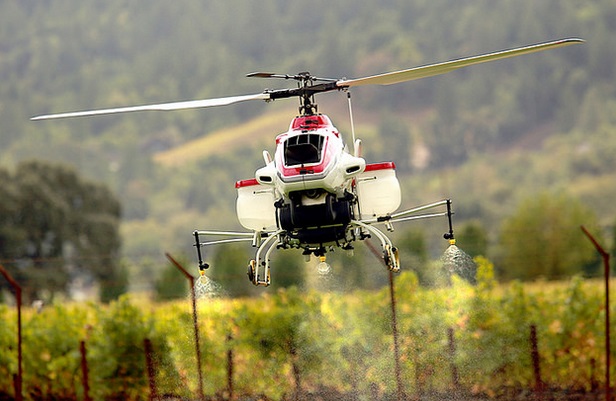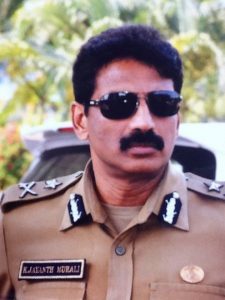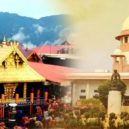DRONING ON THE POLICE DRONES

My biology teacher in school taught me that a drone meant a male bee without stingers which did not gather nectar or pollen but simply existed to copulate with the unfertilised queen. Fast forward to today, the real male-bees in the bee-hives suddenly appear to have got drowned and stifled in the din, buzz, whir and hum of new unmanned aircraft called drones which are all over the skies doing amazing things as well as changing our lives by ushering in a drone revolution.
How about putting a new crime combatant in the skies of Chennai? It’s not a bird, a superman or a plane. You probably guessed it right? It’s a drone. Visualise a scenario of having a fixed-wing drone always hovering and silently fluttering around the city. Let’s say a 100 call comes in for a chain snatching incident or a murder from a random locality in Chennai, where the police need to rush immediately. While the proximate patrol vehicles or police officers would take at least somewhere between 10 to 20 minutes to navigate through narrow bylanes and dense traffic to pull in at the scene, if a police constable from the control room inputs the GPS coordinates the drone could be deployed at the scene swiftly in a fraction of a time. That means we will have eyes on the scene immediately after the crime has been committed, or maybe even when the crime is still in progress. If the suspects flee away from the scene, we can tail them right to the end or else still manage a video footage of the culprits or their vehicle. Deployment of solitary drone in Mexican city just over a few months led to more than 500 arrests and a 10 per cent drop in overall crime rates, with a 30 per cent drop in home robberies. Once the criminals know that police are deploying drones for patrolling, it’s kind of game over for them. Drones can be absolute game changer as the possibilities are colossal for crime fighting. This is a technology that is not going away and will only continue to evolve.
Drones have multiple uses, they can be used as an adjunct to target criminals operating in public places. It’s a mobile equivalent to CCTV. Drones can be deployed in crime hotspots to prevent and detect crimes like it’s being done in the USA. Drones have the capaciousness to find active shooters inside skyscrapers and on rooftops, very cheaply and more unobtrusively than helicopters. Drones can be very useful in recording/ photographing the crime scene. There is always a chance for human investigators to miss out on some valuable clue while combing the crime scene, which could be extracted upon minutely reexamining video footage of the scene. Drones can be extremely useful in surveying disaster sites. It can help the police officers step inside and get a peek in real time of the extent of damage caused by flood, storm, earthquake etc. Aerial data collected by drone can help direct resources toward where they’re needed most, and can help protect first responders by dropping them a dime on the nature of the scene they’re accessing, so they can avoid pitfalls and withhold themselves from danger. Drones can help police officers find missing or lost people. By covering large areas in a short while, a drone can help save a life by locating a person a lot more quickly than could be accomplished by foot. Drones could also be useful in accident and traffic management during major road accidents by visualising the magnitude of the mishap and its impact on traffic flow.
This information could be used to reorient traffic. Drones also help the police to investigate bomb threats remotely, without pushing the officers into dangerous situations. What’s more, drones can help in picking samples of potentially hazmats, like explosives, radioactive substances, spills etc. These samples can then be analysed to evaluate the threat.
Police began using drones more than a decade ago. In earlier days it was just an inceptive technology, only recently drones have acquired tremendous popularity among the law enforcement agencies. Tamilnadu police, Karnataka Police, Telangana police, Gujarat Police, Delhi Police, Rajasthan Police, Maharashtra Police etc have acquired their own drones and have deployed them for police work. In the USA today, there are at least 347 police agencies in 43 states flying drones. Sixty-three per cent of the agencies that acquired drones is police departments and fire departments, which together account for twenty per cent of the agencies in the U.S that have drones.
Tamilnadu purchased 4 unmanned aerial vehicles (UAVs) from Anna University, Chennai in 2014 at a cost of ₹ 95 lakhs. Tamil Nadu is believed to be the first state in the country to have used a drone to investigate a murder. In February 2014, a drone was deployed to investigate the murder of lady software engineer Uma Maheshwari in city’s IT corridor near Siruseri. Tamilnadu Police also has the distinction of having used privately hired drones in December 2017 to nab dacoits hiding amidst dense vegetation and water spread in Vallam, Tanjore, and likewise use it to arrest a gang of ATM robbers last year who stole around ₹ 30 lakhs in the western belt of Tamilnadu. When it comes to law and order, Tamilnadu police has used drones during the Thevar Guru puja festival, Immanuel Sekaran anniversary, and several other occasions including bundobust. For survey purposes, drones were deployed to track illegal granite mining in Madurai, Tamilnadu. As far as deployment of drones for disaster management is concerned, drones were deployed during Chennai floods 2015, Moulivakkam flat collapse disaster 2014, as well as to guide rescuers to trekkers trapped in the raging fires at Kolukkumalai forest area near Kurangani in Theni district during March this year.
Aurangabad Police in Maharashtra has purchased four drones for crowd control which are equipped with a pepper sprayer, which has the ability to spray chilli or pepper powder on unruly mobs and disperse them. Police in Karimnagar district of Telangana is using drones to prevent open defecation and also to keep an eye on people attempting suicide on the river banks as well as for extending an eagle eye surveillance on illegal sand quarrying and transportation. Rajasthan police under the modernisation scheme have purchased 10 drones and have proposed to buy 30 more soon for maintenance of law and order and aerial surveillance. Karnataka Police have imported 12 drones at a cost of ₹1.5 lakhs each and have trained 20 Constables to operate them. These drones are now being used to detect illegal sand mining along Andhra Pradesh – Karnataka border. Kerala has planned to purchase state-of-the-art UAVs having successfully used hired drones at Attukal pongala and Sabarimala. Gujarat Police have purchased two NETRA UAVs which were successfully deployed for the first time during Jagannath Rath Yatra. The Delhi Police authorised DCPs of all 11 districts to purchase drones for aerial surveillance, some of which were used during Trilokpuri riots in 2014, drones were also used in Gurgaon to monitor a demolition drive which witnessed violence. Drones can also be enormously useful to reduce drowning deaths on Marina beach, eavesdrop on rave parties in the beach houses, curb illegal sand mining, monitor traffic, etc Drones are an extremely attractive tool for surveillance, whether it’s tailing a person of interest or peeking into his or her car or home. Privacy hawks are extremely concerned over the dystopian future, hence deployment of drones must not be allowed without paperwork, supervisory sanctions and judicial warrants in order to help their admissibility as evidence in trials. Slaughter Bots, a dystopian film of 2017 shows a future in which palm-sized, autonomous drones use facial recognition technology and onboard explosives to commit untraceable massacres. As is the case with all emerging technology, there are some big questions to be answered. Who will regulate police drones? How can we mitigate privacy concerns? How will we live with a sky full of drones? Ultimately – how can we use this technology to build, love, trust and unity and not splinter the humankind through hatred and suspicion?
Source from: epaper/deccanchronicle/chennai/dt:08.10.2018
 Dr.K. Jayanth Murali is an IPS Officer belonging to 1991 batch. He is borne on Tamil Nadu cadre. He lives with his family in Chennai, India. He is currently serving the Government of Tamil Nadu as Additional Director General of Police, DVAC.
Dr.K. Jayanth Murali is an IPS Officer belonging to 1991 batch. He is borne on Tamil Nadu cadre. He lives with his family in Chennai, India. He is currently serving the Government of Tamil Nadu as Additional Director General of Police, DVAC.


